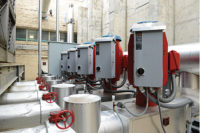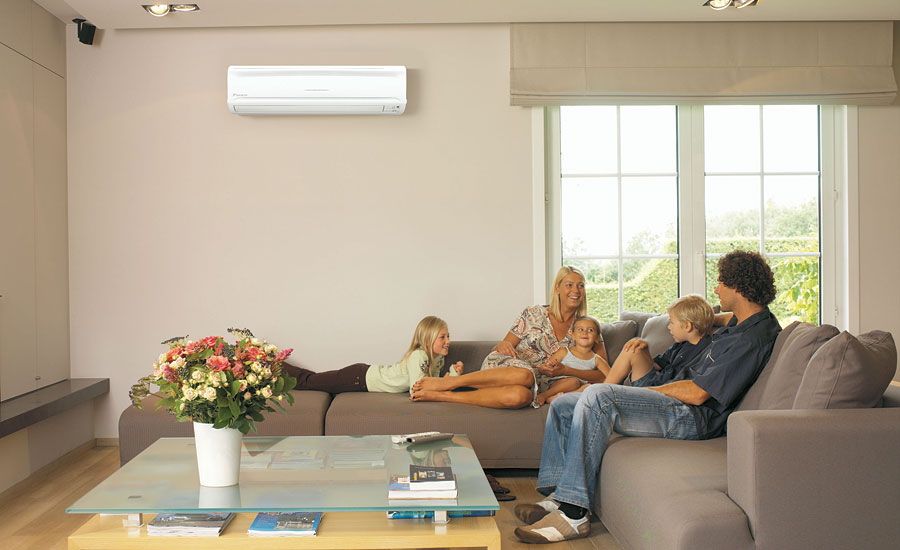Mini-splits are the energy-efficient air-conditioning alternative
Replacing the dinosaur window air-conditioning units are high-efficiency ductless, mini-split systems.








“Ductless cooling and heating technology represents the crossroads of these two requirements for quality HVAC and energy efficiency,” says Mike Smith, senior marketing manager of residential products at Mitsubishi Electric’s U.S. cooling and heating division. “It provides individual temperature control, installation flexibility, energy efficiency and quiet operation that traditional central systems or window units cannot match, regardless of the application.”
A ductless system utilizes refrigerant piping to distribute cooling and heating energy throughout the components of a system, as opposed to ductwork, explains Kelly Hearnsberger, vice president of product marketing at Daikin North America. “At various points in the ductless system, indoor units — a cooling/heating device that combines an evaporator coil, fan and air register into a single device with its own thermostat — are installed,” he says. “These units all connect, through the refrigerant piping network, to a shared condenser or heat pump unit outside the home — the outdoor unit.”
The systems have been in the market for more than 30 years, says Brendan Casey, commercial product manager for Fujitsu General America. “The first U.S. mini-splits were one-to-one systems that could provide heating and cooling for a single room,” he adds. “These were the perfect solution for an addition — such as a garage that is converted to a play room, a later completion of a bonus room or a computer room in a small business.”
Central air-conditioning systems also use one indoor unit and one outdoor unit; however they require ductwork to transport heated or cooled air.
“Installing ductwork in older homes or businesses where it does not already exist can be a huge challenge, is very disruptive, and can be expensive,” Casey explains. “Because there’s no need for air ducts, mini-splits are ideally suited to retrofits and are a great companion for hydronically heated homes — meaning they’re a great source of super-efficient air conditioning for older homes throughout the Midwest, Northeast and East Coast.”
Energy efficiency and comfort
The push for higher efficiency across a broader range of operating conditions is a trend that drives innovation among many manufacturers. “Energy efficiency is no longer a fringe product benefit,” Smith says. “Homeowners now demand that the products in their homes be energy efficient. Ductless cooling and heating systems typically use up to 40% less energy than conventional central air systems and window units.”
The trend is moving toward a whole-house ductless system, adds Donnie King, director of distribution development for Quietside and Samsung HVAC. “This technology is perfect for energy-efficient new construction buildings,” he says.
The industry has seen steady progress in the installation of mini-split systems in new construction, agrees Casey.
“As mini-splits gained acceptance for individual rooms and retrofits, this led to an increase in the willingness of home and business owners to consider mini-split systems for new construction work,” he says. “This led to the development of residential systems that can serve as many as eight zones. It also fueled the growth of variable refrigerant flow systems that can have up to 1,600 indoor units controlled from a single controller.”
These systems are being used in many retrofit projects because building owners get great rebate incentives. “Home and building owners no longer want to pay for conditioning spaces that are not used, so owner’s choice is a huge factor,” King says. “Ductless is used more in retrofit applications now — solving troubled zones inside a building. Energy rebates and local code changes also help the ductless product.”
Casey adds: “In the past, retrofits were the majority of mini-split installations. But today, we find the residential market is about 50/50 retrofit/new construction. This is the trend both for residential projects as well as commercial projects. The success of retrofit installations has led to mini-splits and VRF becoming the first choice for new construction.”
Hearnsberger notes that the use of mini-split air-conditioning systems changes as you move around the country. “In the Northwest, for example, ductless is more well-known and new construction tends to be higher,” he explains. “In the Northeast, there’s more retrofit because people are trying to upgrade buildings as they revitalize urban areas. Ductless fits more easily into older homes and commercial buildings that weren’t designed for air conditioning. Architects upgrading historic structures love these systems.”
The increasing acceptance of the technology is a primary driver of the recent growth.
“You can’t change the way buildings are built overnight, but the leading manufacturers also learned a lot from the North American building market and modified their products in an attempt to fit the needs better,” Hearnsberger says. “It’s interesting to see that domestic manufacturers also are incorporating some of the advanced ductless technology, such as the inverter-controlled compressors, into ducted systems.”
Owners are seeing lower energy bills and more comfort with mini-split systems, King agrees. “Inverter-driven ductless systems match the load inside a building,” he explains. “The constant run time at low speeds uses less energy than the larger, more conventional systems on and off cycle.”
Customized temperature control is a feature that sets these systems apart, Hearnsberger notes, as are other comfort features such as reduced noise levels, an electronic air cleaning feature, variable air motion, occupancy sensing and a remote control.
The use of zones allows homeowners to cool or heat the rooms they use the most, such as the living room, while saving energy in less used areas of the house, such as a guest bedroom, Smith says. “We’ve been trained from childhood to turn off the lights when we leave a room to save energy; ductless zoning systems allow us to do this with the HVAC as well,” he notes.
Another reason mini-splits are cost-effective is because installations go quickly and are not intrusive. “There’s no need to tear up a house to accommodate the need for ductwork,” Casey says. “Of course, there’s the advantage of operational efficiency which has even exceeded the efficiency of many geothermal heat pumps today — without the need for expensive excavation or drilling and geoexchange.”
Contractor acceptance
The two major obstacles for selling ductless are aesthetics and price, Hearnsberger notes. “The typical North American consumer has become accustomed to seeing vents with all the ductwork behind the walls, ceilings and floors; they don’t believe they will like seeing a ductless unit hanging on the wall,” he comments.
However, consumers find that they don’t even notice the indoor units. And the return on investment seems to outweigh concerns of initial costs. The Elliott family in Huntington, Pa. greatly appreciates the multizone split system that was installed at their lake retreat in 2010. “We had the entire system up and running in a day,” says Dave Yates, president of York, Pa.-based F. W. Behler. “The owners were amazed at how easy the installation process was and — now — how their guests have stirred lively conversation about the systems: how comfortable and quiet they are, and how enjoyable it is to have the ‘high tech’ HVAC at their rural, mountainside retreat.”
The Elliott’s have a 36,000-Btu multizone system that provides supplemental heat to three radiantly heated spaces: a lower tool room, a three-bay garage and the 1,000-sq.-ft. upper-level bunkhouse for guests. “Mini-splits are well-suited for use in homes that are hydronically or radiantly heated,” Casey explains. “A key advantage to radiant heat, after all, is that the delivery of that heat — a floor or wall, for instance — is invisible. There are no ‘central system’ ducts. Mini-splits can go in that way, too — with many unobtrusive options for the heating or cooling of buildings.”
Ductless mini-splits tend to lead the industry in technology, Hearnsberger adds, such as the inverter compressor that is common in Daikin’s mini-splits but only recently launched in the first-ever conventional ducted system.
Contractors are surprised by the multitude of behind-the-scenes improvements they see. “For instance, Fujitsu now offers 60,000-plus combinations of indoor and outdoor units,” Casey says. “With that many options, installers can meet essentially any combination of needs at any jobsite.”
Sonny Brennanof Vinyard Haven, Mass.-based Brennan & Co. agrees: “The systems are so flexible, we can do just about anything. It doesn’t matter if it’s a new home, or an old house being restored or whether I am installing ductless or ducted systems; there are many more opportunities these days to solve architectural challenges than ever before.”
Quietside, Mitsubishi Electric, Fujitsu and Daikin all offer training opportunities such as online, local and factory training, which includes a combination of classroom and hands-on learning.
“Training is mandatory,” Hearnsberger says. “Contractors who have been through the manufacturers’ training schools already know these technologies are very different — you can’t just go from installing standard domestic ducted systems to ductless without investing the time in training.”
Looking for a reprint of this article?
From high-res PDFs to custom plaques, order your copy today!











